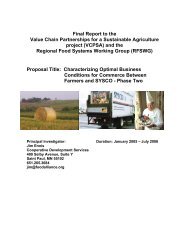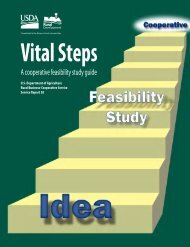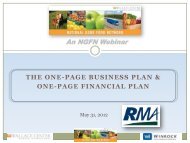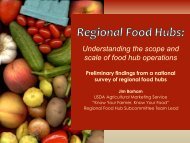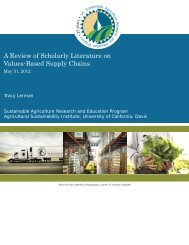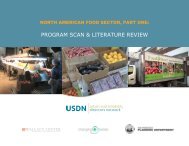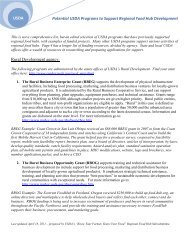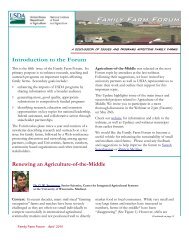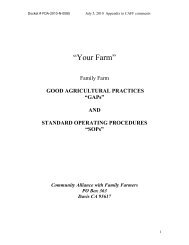The Common Market Feasibility Study - Agricultural Marketing Service
The Common Market Feasibility Study - Agricultural Marketing Service
The Common Market Feasibility Study - Agricultural Marketing Service
You also want an ePaper? Increase the reach of your titles
YUMPU automatically turns print PDFs into web optimized ePapers that Google loves.
THE COMMON MARKET FEASIBILTY STUDYComparable Local Food Distribution Centers324. OPERATION F<strong>The</strong> operation originated as a program of a state-wide sustainable-agriculture nonprofit.Recently, it has transitioned to its own LLC, buying from farmers and working with a localproduce distributor to market product to institutional buyers in the state.5. OPERATION G and one of its retailers<strong>The</strong> operation is a cooperative of dairy farmers that sells to distributors in a mid-Atlantic region.<strong>The</strong> retailer sells the cooperative's products via one of their distributors. While not interviewedfor this report, both the cooperative and the retailer provided pricing information on dairy forthis report vital to the <strong>Common</strong> <strong>Market</strong>’s understanding of dairy distribution, as outlined inAppendix A.Interview Questions1) How do you set your prices?2) What is the approximate average mark-up you apply to farm products you purchase?3) How flexible is this mark-up?4) Once fixed costs are applied, what is your approximate net profit margin?5) Does mark-up vary depending on growing methods? For example, if you distribute bothCertified Organic and conventional produce, do you mark them up the same?6) Do you add fuel surcharges to your deliveries, or is delivery cost built in to the price for yourcustomers?7) What is your minimum order for delivery?8) Do you offer volume discounts?9) What are your payment terms?Quantitative Results1. How do you set your prices?Of the five interviewees, all set their prices to ensure that they break even at year’s end with nospecific net profit margin sought. Two of these use a specific mark-up percentage, derived froma formula that accounts for their fixed costs, to reach their breakeven point, while the other tworely on experience and market factors to evaluate mark-up, adjusting mark-up amounts on aproduct-by-product basis.2. What is the approximate average mark-up you apply to farm products you purchase?Mark-up percentages varied for each distribution business based on the fixed costs for eachbusiness. Variance on these numbers is consistent with the fact that each of these operations isstructured slightly differently, which affects the quantity of fixed cost they incur and the dollaramount of mark-up, as each seeks to break even as their sales goal.3. How flexible is this mark-up?75% of the interviewees confirmed mark-up flexibility on a per product basis to some extent.One of these identified a range of 8% depending on the item, though they have an end numberthat is generally sought, while the other two said the flexibility is solely dependent on marketdemand for that item.4. Once fixed costs are applied, what is your approximate net profit margin?



